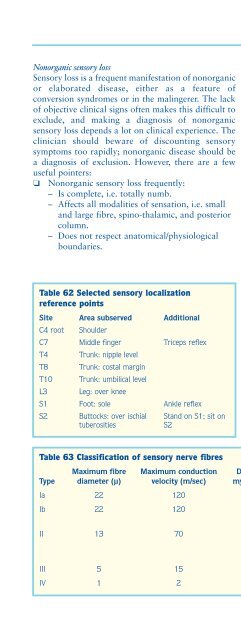Create successful ePaper yourself
Turn your PDF publications into a flip-book with our unique Google optimized e-Paper software.
Disorders of sensation221Nonorganic sensory lossSensory loss is a frequent manifestation of nonorganicor elaborated disease, either as a feature ofconversion syndromes or in the malingerer. The lackof objective clinical signs often makes this difficult toexclude, and making a diagnosis of nonorganicsensory loss depends a lot on clinical experience. Theclinician should beware of discounting sensorysymptoms too rapidly; nonorganic disease should bea diagnosis of exclusion. However, there are a fewuseful pointers:❏ Nonorganic sensory loss frequently:– Is complete, i.e. totally numb.– Affects all modalities of sensation, i.e. smalland large fibre, spino-thalamic, and posteriorcolumn.– Does not respect anatomical/physiologicalboundaries.❏– Has circumferential cut-off on the limbs.– Completely respects the mid line.– Respects patients’ modesty!– Is associated with unusual (nonorganic)postures and movements.– Has absent associated features/signs.On examination it is worth checking for:– Vibration loss that respects the mid line onface and thorax; in genuine sensory lossvibration can be appreciated by thecontralateral (normal) side.– Nonpronating arm drift.– Withdrawal or an emotional response topainful stimuli, while denying appreciation.– Lack of trophic changes.– Consistent reporting of the direction oppositeto the direction of actual movement whentesting proprioception.Table 62 Selected sensory localizationreference pointsSite Area subserved AdditionalC4 root ShoulderC7 Middle finger Triceps reflexT4 Trunk: nipple levelT8 Trunk: costal marginT10 Trunk: umbilical levelL3 Leg: over kneeS1 Foot: sole Ankle reflexS2 Buttocks: over ischial Stand on S1; sit ontuberositiesS2None of these features individually points tononorganic sensory loss, and some are features oftrue sensory loss. In addition, patients often try tohelp or impress the examiner by elaborating theirsigns. Also, patients manifesting gross nonorganicfeatures may have a genuine, often minor underlyingdisorder. However, usually an overall pattern emergessuggesting nonorganic disease.Patterns of sensory disturbancePatterns of sensory loss, taking into account theirdistribution and evolution, suggest the site and natureof the lesion. Single-site focal loss suggests a root orperipheral nerve lesion. Compressive causes arefrequently painful (e.g. sciatica). AssociatedTable 63 Classification of sensory nerve fibresMaximum fibre Maximum conduction Degree ofType diameter (µ) velocity (m/sec) myelination FunctionIa 22 120 +++ ❏ Muscle spindle primary afferentsIb 22 120 +++ ❏ Golgi tendon organs❏ Touch and pressure receptorsII 13 70 ++ ❏ Muscle spindle secondary afferents❏ Touch and pressure receptors❏ Pacinian corpuscles (vibratory sense)III 5 15 + ❏ Touch, pressure, pain, and temperatureIV 1 2 - ❏ Pain and temperature
















